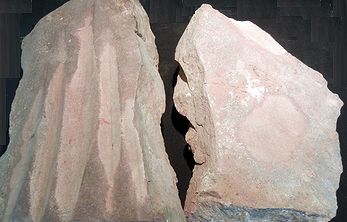The Neolithic is the most recent of the three "stone ages": Paleolithic ("Old Stone Age"), Mesolithic ("Middle Stone Age"), and Neolithic ("New Stone Age").
In most parts of the world, the Neolithic period is, of course, associated with the dawn of agriculture. But with respect to the surviving stone tools, what is new about the New Stone Age is a process by which tools were initially formed by regular stone knapping and then abraded to produce a flat or curved surface, rather than the irregular surface produced by earlier chipped stone. Chipped tools continued to be used to a limited extent, of course, but it is startling what a large proportion of Neolithic stone tools exhibit partial, or more often total surface smoothing.
While chipping (knapping) produces sharp edges on glass-like stones such as flint or obsidian, other, often sturdier, materials such as limestone cannot be so worked. They make excellent tools when a very sharp edge is not necessary. To make tools from these stones, they are broken into roughly the desired shape, and then abraded until the finished tool is produced.

Many of the activities associated with Neolithic ground stone are linked to agriculture. For example, milling grain requires a close fit between the two millstones (or between the mano and the metate).
(Of course, milling will tend to wear the stones smooth quite quickly even if they did not start that way. Archaeological sites across the American Southwest are full of prehistoric mortars and "cupules" that were created by grinding acorns or other materials in small indentations in the rock using hand-held stone pestles. It is not clear how much preliminary abrasion of the rock was done before a given cupule or mortar was put into use. Cupules, mortars, and occasional pestles are all examples of pre-Neolithic ground stone tools, although the grinding may have come more from use than by design.)
 .
. Other activities (such as hoeing or chopping out brush or trees to make gardens) made use of tools that typically were deliberately ground and polished. Such activities required sturdy stones but not particularly sharp, blade-like edges.
That said, many Neolithic stone tools seem to be more heavily worked than would be necessary for the tasks they seem to have been intended to accomplish. Must an ax be truly polished? Must it be smooth over its entire surface? Must a hoe? Why?
Polishing. Rather mysteriously, in the Neolithic even such tools as spear heads, arrow heads, and knives made of flint, chert, and obsidian were also often abraded and polished to have smooth surfaces, for which there is no discernible necessity.
I have found no source so far (and no expert) who is able to provide a credible explanation for the "excessive" use of ground stone in the Neolithic.
- One archaeologist suggested that perhaps there is some bias in the preservation of this material, only the "beautiful" and more costly items being concentrated at living sites, while the grubby chipped tools were discarded whenever they were broken. The explanation is lame, however, for archaeologists tend to stumble onto such material whether or not it has been concentrated in living sites, and in any case living sites should contain tools actually used, not just ones that are admired.
- Another explanation runs to the possibility that people simply liked smooth stones and could bully others into smoothing them. It seems odd to imagine smoothness as a simple fad lasting for thousands of years and covering the globe, however.
- Yet another explanation is that smoothing is a lot easier than it looks and that the advantages of a predictably regularized stone tool outweigh the small effort involved in abrading it. But modern "rock hounds" polish rocks by subjecting them to much higher speed electric polishers and it still takes a long time, so doing it by hand hardly seems trivial.
If you figure out the answer to this mystery, let me know!
Click here for the Neolithic in general.
